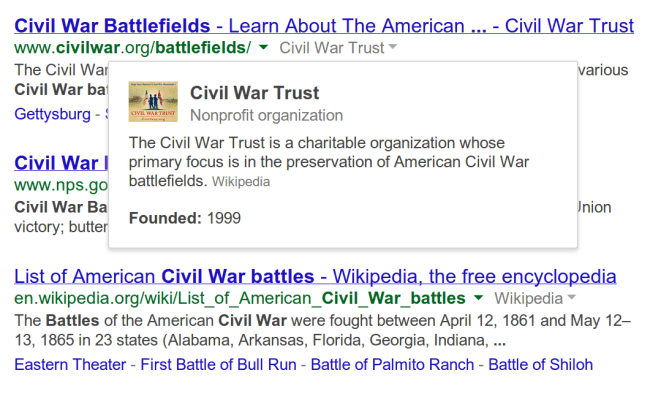Google’s Knowledge Graph is getting baked into actual search results, the company is announcing today. In a blog post on its official Search Blog, Google explains how you’re now able to learn more about the topics you’re searching for by clicking names that appear next to a given link in your search results.
These additional, informational widgets are only appearing in desktop searches at present.
In the provided example, a search for “Civil War battles” may be tagged with another small link, which, when clicked reveals a drop-down box summarizing that page’s topic. In the picture shown (see above), an extra link titled “Civil War Trust” pops up a box that offers a one-sentence explanation about the nonprofit being referenced, including the date of its founding.
These new links are small and gray, so as not to impact the search experience. They appear beneath the larger blue link, and next to the actual site URL (green link).
The extra information will only be provided for sites that are “widely recognized as notable online,” says Google, which means that it’s not likely that you’ll see some random person’s blog on page 10 of Google’s search results getting the same treatment.
The additional information is powered by Google’s Knowledge Graph, a semantic search effort the company first introduced back in 2012 as a way to make Google Search smarter by infusing it with an understanding of the people, places, and things in its search index.
Since that time, the Knowledge Graph has gone on to touch nearly every aspect of Google’s search, including Google Trends, its mobile card-style interface, searches involving statistics, and much more, in addition to also providing at-a-glance information to the right and sometimes top of Google’s Search results.
Like some of the Knowledge Graph enhancements that have come before it, the new informational pop-ups could impact click-throughs on the pages returned in the search results. For instance, if the searcher was only looking for a brief explanation or fact-check, the pop-up could suffice. But Google purports this extra info is instead designed as a way to help you choose the right result from its list of blue links, not avoid them.
